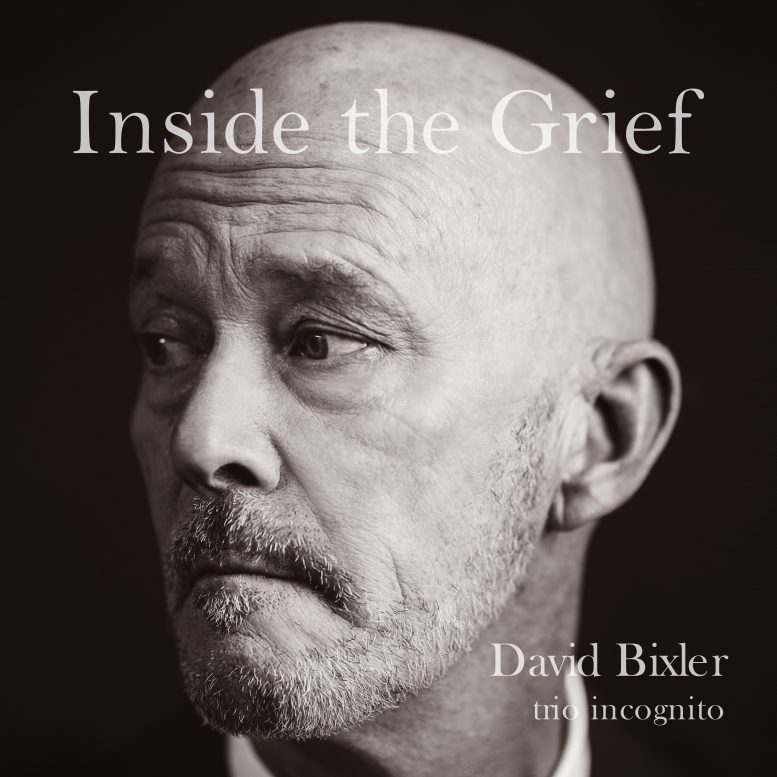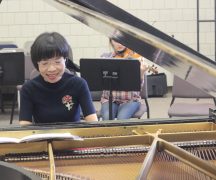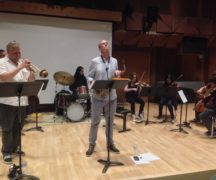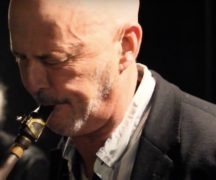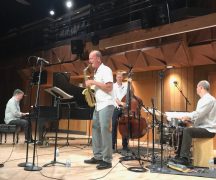By DAVID DUPONT
BG Independent News
A pandemic, civil unrest, a divisive election – 2020 is an unforgettable year that most of us would like to forget.
Jazz performer and composer David Bixler has produced music to memorialize 2020. “Inside the Grief” is now available to stream or purchase a download.
“’Inside the Grief’ is a product of these strange times in which we are living,” Bixler writes in the liner notes to the session.
Back on March 13, Bixler, director of Jazz Studies at BGSU, took a flight from Detroit intending to spend spring break with his family at his home in New York City. He had a gig that night with his ensemble Trio Incognito. He arrived as the lights were going out in night life in the city, and across the nation. He never played that night. The show to celebrate the release of his “Blended Lineage” recording was just one more victim of the pandemic. The project is in ways his most ambitious, featuring a string quartet including his wife Heather Martin Bixler on violin.
He and his family – his wife, his teenage son, his grown daughter and her boyfriend, were in their apartment in Harlem on the boundary with Washington Heights. All of them either taking or teaching classes online.
He kept playing. He told BG Independent in April he was woodshedding the Thelonious Monk songbook. He was also spending time helping his son, Sean, with his online schoolwork.
For his sanity and that of his family, Bixler and his saxophone took to the open air much like jazz legend Sonny Rollins used to practice on the Williamsburg Bridge during his hiatus from music 60 years ago. Bixler wasn’t alone. He joined other musicians in backyards and parks. Later he reached out to the Soapbox Gallery. The venue had been scheduled to present the “Blended Lineage” release party. Now they were doing livestream sessions. He and his wife also did a session centered on being married musicians.
Bixler did a couple sets with Trio Incognito, as large a group as the venue was comfortable hosting.
“Inside the Grief” had its roots there.
During a livestream from the venue in September, his father heard him play an original, so new it didn’t have a title yet. According to Bixler’s liner notes, his father heard a call to action in it – Vote! Vote! Vote!
So, “Vote!” closes out “Inside the Grief.”
The session features Bixler lean, metallic tone imbued with human urgency. Bassist Gregg August has a round, woody tone that thrums underneath, surfing the currents of drummer Fabio Rojas’ shifting rhythmic patterns.
Fitting for the times, nothing here seems locked in – the harmonies often refuse to resolve neatly, the rhythms agitate. Bixler has his own distinctive melodic vocabulary that he employs with a keen sense of inner architecture.
The trio engages in fluid interplay throughout, commenting on and extending each other’s musical gestures.
The title song encapsulates the mood of the session – opening with an anxious opening phrase that shifts into lament. After reiterating the opening phrase, the rhythm section continues with the unsettled beat while Bixler plays the lament over the top. The emotional riptide captures the uncertainty so many people have felt during these times.
The session opens on a more personal note. Bixler and his family have been struggling for more than a decade with his youngest son Sean’s brain injury. That’s involved surgery and treatments and great uncertainty.
“What Does It Care?,” the brusque abstract blues that opens the session draws its title from the phrase Sean used as he emerged from brain surgery and he struggled with making verbal connections.
A drum solo by Fabio Rojas leads into “I Spy,” a somber composition from a series inspired, Bixler writes, by the Beatitudes. Bixler includes another piece from that set, the walking ballad “Balm.”
Another piece reflecting on Sean’s condition, “389,” offers the most straightforward swing on session.
The dark tango, “Like Shosti” shows the range of influences on Bixler’s music. Inspired by John Coltrane’s tribute to Rollins, “Like Sonny,” Bixler delivers a melodic fragment from Russian composer Dmitri Shostakovich in telegraphic fashion, and teases it out in his solo in a way that evokes Rollins’ own theme-based approach to improvisation.
All adds up to memorable music reflecting an historic time.

